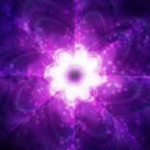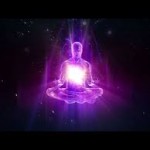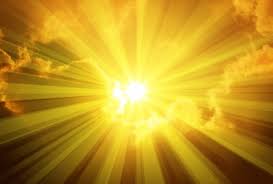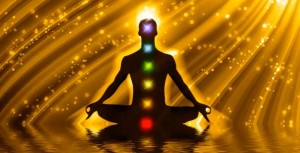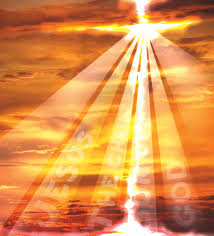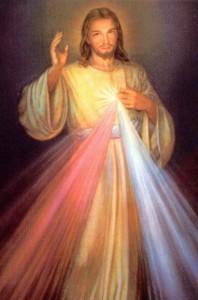- Introduction
- What is Sexual Energy?
- Jesus and the Teaching of Higher Truths
- Sexual Energy and the New Testament
- Subtle Energies in the New Testament
- The Chakras in the New Testament
- The Wise Use of Sexual Energies
- The Birth of Christ Consciousness
- The Unwise Use of Sexual Energies – Part I
- The Unwise Use of Sexual Energies – Part II
- Attacks on the Light
- Beyond the Biological
- A Spiritual Ethos of Sexual Energy
- Final Thoughts
I. Introduction
Sexual energy is the most powerful energy within us. It is often referred to as the “life force” because it is so powerful. Without this vital force we would be unable to live fully in the world and be effective agents of our destinies. Yet, Christianity throughout its long history has misunderstood sexual energy. The adverse consequences of this misunderstanding are hard to overstate. They have been vast not just for the lives of individual Christians but for all of Western culture, which has been shaped by the worldview, beliefs and doctrines of Christianity and the norms and values born from them. Christian spirituality has likewise been adversely affected in immeasurable ways by the failure of Christianity to properly understand sexual energy and its role in spiritual transformation, greatly hindering Christians in fulfillment of their needs and desires for a deeper spiritual life.
This article examines sexual energy within the context of New Testament texts that reveal the critical importance of sexual energy in the very thing that Jesus offered to the world: salvation. While the New Testament does not explicitly refer to sexual energy, certain New Testament passages, through symbol and metaphor, teach of sexual energy and its importance for spiritual transformation and, ultimately, for salvation. The interpretation of these canonical texts, which include parables and much of the Book of Revelation, as containing references to sexual energy opens us to the very real possibility that Jesus knew of the importance of sexual energy for higher spiritual attainment and that he taught this truth when he walked the earth and in his post-resurrection appearance to the apostle John recorded in the Book of Revelation.
What we find in these texts is that sexual energy is a spiritual force and that its proper understanding and use are crucial for the realization of the inner Christ revealed by Jesus to be the divine essence within all humankind. These texts further teach that this divine essence, our Christ consciousness, is the gateway to union with God, which Jesus taught to be the pinnacle of spiritual attainment and the culmination of the spiritual quest, and that sexual energy is one of the most powerful forces to help us consummate this divine union and to gain the freedom that it brings.
II. What Is Sexual Energy?
Sexual energy refers to the energies of the two lower chakras, or energy centers, commonly referred to as the root chakra and the seat of the soul chakra. The term chakra is derived from the Sanskrit cakra , meaning wheel. The chakras, when open and flowing with energy, appear to persons who can see these energies as wheels or centers of light. The term chakra is commonly used to refer to the seven major energy centers within the energy body, one of several sheaths of subtle energies surrounding and interpenetrating the physical body. Taken together, these subtle energy bodies form an energetic field surrounding the physical body and are often described as the human aura. The energy body acts as an energetic template of the physical body; and, together with the other subtle energy bodies, it fills and animates the physical body with life-giving energies.
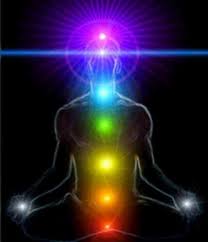
The Seven Major Chakras
The seven major chakras are located in parts of the energy body corresponding in the physical body to the base of the spine (root chakra), below the navel (seat-of-the-soul chakra), solar plexus (solar plexus chakra), center of the chest close to the heart (heart chakra), middle of the forehead just above the eyes (third-eye or wisdom eye chakra), and crown of the head (crown chakra). Colors associated with each chakra in ascending order are red, orange, yellow, green, blue, indigo and violet.
The energies of the two lower chakras, as do all chakra energies, have many functions. A primary function of the two lower chakras is in their interplay with biological processes in sex and procreation. While most often associated with these aspects our lives, the energies of the lower chakras also play other very important roles. When used for non-sexual ends, they are powerful forces helping us to achieve goals and fulfill purposes in virtually all areas of our lives. So vital are these energies that in many ways they are among the most defining features of our lives and contribute in countless ways to making us who we are. For example, the word “charismatic”, which is derived from the French charis meaning grace, is often used to describe persons who have an abundance of sexual energy and use it to influence, consciously or unconsciously, others and the world around them. Sexual energy coupled with intent, often experienced as desire, increases the likelihood of a person realizing intended or desired goals on outer and inner levels.
Sexual energy, as one of the most powerful forces in our lives, can be used to achieve ends that are good or ends that are bad, ends that enhance and enlighten our lives and [pullquote]So vital are these energies that in many ways they are among the most defining features of our lives and contribute in countless ways to making us who we are.[/pullquote]world or ends that diminish and destroy us and the world around us. Used properly, sexual energy can fill a person with light and help them to be more loving. Used improperly, sexual energies can render a person hostage to untoward intentions and desires harmful to themselves and others. It is a force so powerful that how we choose to relate to it shapes much of our lives on earth, as well as our destinies after we pass from this world into the beyond.
Hinduism and Buddhism, among the world’s great religions, have long known of the chakras and the power of their energies. With the advent of Eastern spirituality and practices, including yoga and Eastern forms of meditation, into the West, the importance of the chakras and other forms of subtle energies has become increasingly recognized by Western spiritual seekers. This knowledge is slowly transforming Western spirituality as a syncretism of Eastern and Western spirituality gradually evolves. Moreover, many people are increasingly looking to the chakras and subtle energies for a fuller understanding of physical and psychological health and illness. For example, physical illnesses will often manifest in the energy body before it becomes symptomatic in the physical body, suggesting that physical illness originates in weaknesses, imbalances or blockages in the energy body. Similarly, psychological conditions, like depression and anxiety, have energetic correlates in the energy body, as well as in other subtle bodies. As such, the energy field surrounding a depressed person will often have dark or discolored energies that carry a low vibration and that are not flowing, causing or contributing to a host of symptoms, such as lethargy and hopelessness, associated with depression.
III. Sexual Energy and the New Testament
If sexual energies are so crucial for our spiritual lives, why are they not taught about or spoken of explicitly in the New Testament? And, even more so, if the attainment of higher spiritual consciousness is closely tied to sexual energies, why do the foundational documents of Christianity not candidly address this? There may be many reasons for the absence of explicit references to sexual energy in the New Testament, and we can only surmise as to what these reasons might be.
In many ancient traditions, the spiritual power of sexual energy was well known. In these traditions, the shaman/shamanness or priest/priestess who had mastered these energies was often the most revered and powerful person in the community and often held positions of great authority. However, these traditions often kept secret the knowledge of sexual energy and its power because of the potential for its misuse to  gain control over or to harm others. Like anything powerful, sexual energy brings with it the temptation to use it for personal gain. This is especially true for persons who are not spiritually developed or who have consciously chosen a path of darkness. When they discover the power of sexual energy, they often use it for purposes harmful to others and, ultimately, to themselves. For these reasons, knowledge of sexual energy and its power was often transmitted through secret teachings and initiations reserved for a select few, which may have been the case with Jesus and the teaching of higher truths to his inner circles of disciples.
gain control over or to harm others. Like anything powerful, sexual energy brings with it the temptation to use it for personal gain. This is especially true for persons who are not spiritually developed or who have consciously chosen a path of darkness. When they discover the power of sexual energy, they often use it for purposes harmful to others and, ultimately, to themselves. For these reasons, knowledge of sexual energy and its power was often transmitted through secret teachings and initiations reserved for a select few, which may have been the case with Jesus and the teaching of higher truths to his inner circles of disciples.
Jewish tradition also may also have limited what Jesus could publicly teach about sexual energy. The spiritual role of sex and sexual energy was not discussed in Hebrew scripture. With some exceptions, notably in Proverbs and Song of Solomon, Old Testament references to sex are mostly prescriptions governing sexual behavior. Absent references in their sacred texts to sexual energy and its role in attaining higher spiritual states and a closer relationship with God, Jews of Jesus’ times would have found it difficult to grasp the spiritual nature of sexual energy and its higher purposes. They may even have rejected such teachings as inimical to their beliefs and traditions. Even today, it is very hard for many people to understand the higher purposes of sex and sexual energy.
IV. Jesus and the Teaching of Higher Truths
If Jesus taught higher truths, including truths related to sexual energy and its role in spiritual transformation, these teachings would most likely have been reserved for his more advanced disciples. In this regard, it is important to note that the gospels explicitly state that Jesus taught his more advanced disciples in ways different from those he used to teach the vast majority of the people who flocked to him, which the gospels call the multitudes. Thus, Mark 4:33-34 states: “And with many such parables He spoke the word to them (the multitudes) as they were able to hear it. But without a parable He did not speak to them. And when they (Jesus and his closest disciples) were alone, He explained all things to His disciples.”
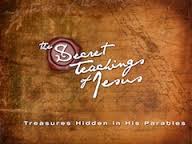 The gospels likewise tell us that Jesus used the symbolism of parables to convey higher truths, presumably to those with a higher consciousness capable of grasping such truths. When his closest disciples are puzzled as to why Jesus used parables to teach the multitudes, he explains to them that they are able to comprehend truths that the multitudes are unable to understand: “And the disciples came and said to him, ‘Why do you speak to them (the multitudes) in parables?’ He answered and said to them, ‘Because it has been given to you to know the mysteries of the kingdom of heaven, but to them it has not been given.’” Mt 13:10-11. Jesus similarly clarifies to his inner circle: “To you it has been given to know the mystery of the kingdom of God; but to those who are outside, all things come in parables…” Mk 4:11. These passages tell us not only that Jesus taught in more direct ways to his closest disciples but also that his teachings of the kingdom of God were higher truths that most of his followers could not grasp directly, thus necessitating his choice to teach them of the kingdom, the centerpiece of his life and mission, through the symbols and metaphors of parables.
The gospels likewise tell us that Jesus used the symbolism of parables to convey higher truths, presumably to those with a higher consciousness capable of grasping such truths. When his closest disciples are puzzled as to why Jesus used parables to teach the multitudes, he explains to them that they are able to comprehend truths that the multitudes are unable to understand: “And the disciples came and said to him, ‘Why do you speak to them (the multitudes) in parables?’ He answered and said to them, ‘Because it has been given to you to know the mysteries of the kingdom of heaven, but to them it has not been given.’” Mt 13:10-11. Jesus similarly clarifies to his inner circle: “To you it has been given to know the mystery of the kingdom of God; but to those who are outside, all things come in parables…” Mk 4:11. These passages tell us not only that Jesus taught in more direct ways to his closest disciples but also that his teachings of the kingdom of God were higher truths that most of his followers could not grasp directly, thus necessitating his choice to teach them of the kingdom, the centerpiece of his life and mission, through the symbols and metaphors of parables.
Jesus further states that some higher truths are not meant for all people. In other words, some higher truths are meant to remain secret, presumably until people attain a higher level of consciousness at which they can grasp the truths and not misuse them. Referring to Isaiah 6:9, Jesus further explains to his disciples that he used parables so that the most of his listeners would not understand the deeper truths: “To you it has been given to know the mysteries of the kingdom of God, but to the rest it is given in parables, that ‘Seeing they may not see, and hearing they not understand.’” Lk 8:10. It appears that Jesus, like many spiritual masters, knew that higher spiritual truths require not only a higher spiritual consciousness in order to comprehend them but also a higher spiritual consciousness in order not to fall prey to the very real dangers of using the knowledge in ways harmful to themselves or others.
[pullquote]The gospels likewise tell us that Jesus used the symbolism of parables to convey higher truths, presumably to those with a higher consciousness capable of grasping such truths.[/pullquote]Jesus, moreover, continued to teach after his resurrection, and much of what he taught in post-resurrection appearances is not recorded in the New Testament or is recorded in highly symbolic language. The Gospel of Luke tells us that Jesus appeared to his disciples after his resurrection and taught them truths about the Scriptures: “He opened their understanding that they might comprehend the Scriptures.” Lk 24:45. But Luke is silent as to what these truths were that illuminated the disciples’ understanding allowing them to comprehend the Scriptures in a new light. In another post-resurrection appearance, Jesus unveiled to the apostle John extraordinary spiritual truths encoded in highly symbolic language. These truths have been passed down to us in the Book of Revelation, which states that the truths given were only for those “who have ears to hear.” Rev 2:7, 11, 17, 29; 3:6, 13, 22. Revelation, which became formally sanctioned by the Church when it was included in the official church canon, is replete with higher truths requiring a more developed consciousness to recognize and understand.
Non-canonical gospels also suggest that Jesus taught truths unrecorded in the New Testament. In the Gospel of Phillip, Jesus kisses Mary Magdalene on the lips, prompting Peter to protest that Jesus may have taught her truths not taught to other disciples. And, in the Gospel of Mary, Mary Magdalene teaches the apostles higher truths that Jesus taught to her but not to others.
Based on what the New Testament tells us, it is indisputable that Jesus taught higher truths to his inner circle of disciples and that he taught these truths during his lifetime and in post-resurrection appearances. We can also reasonably conclude that, if Jesus taught higher truths, they are important for understanding his life and mission. The New Testament, with some notable exceptions, such as the prologue to the Gospel of John, does not explicitly state what these higher truths are. Yet, we can discover at least some of these truths, actually very important ones, in certain New Testament passages when they are illuminated by an understanding of subtle energies and their role in spiritual transformation. Then we may find truths hidden in the foundational texts of Christianity, which have awaited a more enlightened consciousness to emerge in order to be recognized and known, not by a select few, but by all who aspire to transform themselves and the world.
V. Subtle Energies in the New Testament
The New Testament refers to subtle energies in several passages, indicating that Jesus knew about these energies and their role in spiritual transformation and higher consciousness. These references, when properly understood, provide a more complete picture of Jesus and his mission, including his identity and the salvation he offered the world. Support for Jesus knowing about subtle energies is found in texts in which these energies are referred to in ways linking them to Jesus’ essence as a being of pure light and to his identity as the Messiah. Support is also found in gospel accounts of healings done by operation of these energies, as well as in the extraordinary revelations in the Book of Revelation about the chakras and their subtle energies.
[pullquote]The New Testament refers to subtle energies in several passages, indicating that Jesus knew about these energies and their role in spiritual transformation and higher consciousness.[/pullquote] New Testament texts often refer to subtle energies as light, which they appear to be when they are vibrating at a high frequency. The Gospel of John opens with the revelation that Jesus is Light and that this Light is essential to all humankind, stating that Jesus “was the true Light which gives light to every man who comes into the world.” Jn 1:9. As we will see in other passages, the word ‘light’ in gospel verses is not used metaphorically, but describes something very real. The veracity of light becomes abundantly clear in Jesus’ transfiguration on Mt. Tabor (Mt 17:1-2), considered by many New Testament scholars to be one of the ‘high points’ of the gospels. In Jesus’ transfiguration, he unveils to three of his closest disciples his true nature as a being of light. We find nothing in the accounts of this extraordinary event that leads us to conclude that Peter, James, and John, the disciples who witnessed Jesus’ transfiguration, believed that the light they saw to be anything other than real.
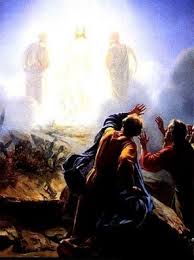
Jesus’ Transfiguration on Mount Tabor
Jesus’ transfiguration on Mt. Tabor is one of the most important of all New Testament apocalypses. The word apocalypse comes from the Greek apocalypsis meaning unveiling. The revelations of Jesus’ true nature as light, in the prologue to John and in his transfiguration, highlight the importance of subtle energies in understanding Jesus and his mission. In his transfiguration, Jesus unveiled not only the existence of subtle energies in the form of light, in what might be called his light body, but he also revealed their role in salvation. The centrality of light in the salvation Jesus offered the world can be fully understood when seen in the context of the passages leading up to the transfiguration. In these passages, Jesus reveals to his disciples that he is the Messiah, but not the kind they anticipated. He makes clear that he did not come to establish a religio-political kingdom, like that of David (Mt 16:13-28), but to proclaim a kingdom of a different sort, one to which all humankind is heir. And he disclosed the quintessential nature of this kingdom when he revealed himself as a being of pure light.
The light Jesus unveiled on Mount Tabor is essential for understanding ourselves and our rightful place in the world. As revealed in the prologue to the Gospel of John, we in our essence are light. And Jesus’ striking revelation of his light body, a body of subtle energies vibrating at a high frequency, the frequency of love, is critical to understanding what he meant by salvation. We will overcome darkness and evil and transform ourselves and our world only when we turn to the light and become, like Jesus, beings of light. Then, and only then, will we walk in the kingdom of God that Jesus proclaimed, a kingdom of pure light, Jesus did when he walked the earth. Salvation seen in this way may seem beyond our reach. Speaking of entering this kingdom, Jesus reassured his disciples: “With men this is impossible, but with God all things are possible.” Mt. 19:26.
[pullquote]As revealed in the prologue to the Gospel of John, we in our essence are light.[/pullquote]References to the subtle energies and their power to transform are also found in other gospel narratives. For example, when Jesus walks through a bustling crowd, a woman ill for many years touches the border of his garment and is immediately healed. Having felt energy leave him, Jesus asks: “Who touched me?” Lk 8:45. Peter responded that there were so many people thronged around him that it was impossible to know who had touched him. But Jesus, having felt a loss of energy, insisted: “Somebody touched Me, for I perceived power going out from Me.” Lk 8:46. This was not an isolated event but occurred frequently when people touched Jesus’ clothes: “And as many as touched his [garment] were made perfectly well.” Mt 14:36. The healing energies he carried in and around him—that he was and is—filled the clothing he wore and could be transmitted to others by nothing more than a touch.
These gospel passages tell us that the energy field around Jesus consisting of subtle energies was perceived by others as light and had the power to heal. We will find, upon examining other gospel texts, that of singular importance among these subtle energies are the energies of the chakras. Once we understand that Jesus knew about subtle energies, including those of the chakras, and their role in spiritual transformation, we can begin to see in New Testament texts teachings about subtle energies and how we are called to use these energies to become, like Jesus, beings of light
VI. The Chakras in the New Testament
The energies of the chakras are subtle energies, and the gospels tell us that Jesus knew about these energies. It therefore is hard not to conclude that Jesus understood the power of these energies and their role in attaining higher spiritual states. As the gospels tell us, Jesus used parables to teach higher truths, the truths being embedded in the symbolism of parables. As such, one way to discover what these higher truths are is to examine the deeper—and often hidden—meanings of parables, as well as of other passages in which Jesus speaks symbolically of higher truths. What we find in these texts is that Jesus did in fact teach about the chakras and the vital role of their energies for our spiritual transformation and salvation.
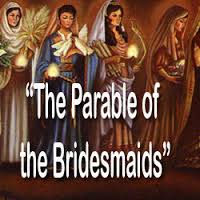 The Parable of the Bridesmaids can be reasonably interpreted as a teaching about the spiritual nature of the chakras and their role in attaining union with the Divine. In this parable, also known as the Parable of the Wise and Foolish Virgins, Jesus tells of ten virgins awaiting the arrival of the bridegroom. They have lamps and oil for the lamps. Five virgins use up their oil and ask the other virgins to share theirs. The latter refuse to do do, and the virgins without oil go in search of it. In their absence, the bridegroom arrives and the wedding feast begins. Upon returning, the five who went in search of oil were denied entry into the feast. This story is rich in symbolism about attaining higher spiritual states and, ultimately, the Divine Marriage. The lamps can be interpreted as representing the chakras, the oil the energy of the chakras, and the wedding feast union with God. The parable teaches “for those with ears to hear” that If we do not use wisely the energies of the chakras, we will be incapable of attaining union with God, the salvation Jesus offered our world.
The Parable of the Bridesmaids can be reasonably interpreted as a teaching about the spiritual nature of the chakras and their role in attaining union with the Divine. In this parable, also known as the Parable of the Wise and Foolish Virgins, Jesus tells of ten virgins awaiting the arrival of the bridegroom. They have lamps and oil for the lamps. Five virgins use up their oil and ask the other virgins to share theirs. The latter refuse to do do, and the virgins without oil go in search of it. In their absence, the bridegroom arrives and the wedding feast begins. Upon returning, the five who went in search of oil were denied entry into the feast. This story is rich in symbolism about attaining higher spiritual states and, ultimately, the Divine Marriage. The lamps can be interpreted as representing the chakras, the oil the energy of the chakras, and the wedding feast union with God. The parable teaches “for those with ears to hear” that If we do not use wisely the energies of the chakras, we will be incapable of attaining union with God, the salvation Jesus offered our world.
The Book of Revelation also teaches of the chakras and reveals, through elaborate symbolism, the far-reaching consequences of the use and misuse of their energies. At its deepest levels, Revelation is a series of profound revelations on the chakras and how the use and misuse of their energies affects the destinies of every soul on this planet and the planet itself. It opens with Jesus appearing to John in the midst of seven golden lampstands. The lampstands can be interpreted to symbolize the chakras, just as do the lamps in the Parable of the Bridesmaids. Jesus also appears to John, as he did in the transfiguration, as a being of radiant light, unveiling in this pure light what awaits those who use wisely the energies of their chakras. As John recounts:
“Then I turned to see the voice that spoke with me. And having turned I saw seven golden lampstands, and in the midst of the seven lampstands One like the Son of Man, clothed with a garment down to the feet and girded about the chest with a golden band. His head and His hair were white as snow, and His eyes like a flame of fire; His feet were like fine brass, as if refined in a furnace, and His voice as the sound of many waters; He had in His right hand seven stars, out of His mouth went a sharp two-edged sword, and His countenance was like the sun shining in its strength.” Rev 1:12-16.
We know that Revelation is encoded with deep truths expressed symbolically because Jesus clearly says that it is. He tells John that the seven lampstands and seven stars should not be taken literally. He is letting John—and us–know that he is speaking symbolically and that he is about to unveil truths yet unknown to the minds and hearts of many who desire a path out of darkness and into light. He tells John:
“The mystery of the seven stars which you saw in My right hand, and the seven golden lampstands: The seven stars are the angels of the seven churches, and the seven lampstands which you saw are the seven churches.” Rev 1:20.
Having interpreted the seven stars as the angels of the seven churches and the seven lampstands as the seven churches, Jesus gives John messages relating to each of the churches. We know that Jesus is speaking symbolically in these messages, for after each message he repeats verbatim that only certain people will understand the deeper meaning of the messages: “He who has an ear, let him hear what the Spirit says to the churches.” Rev 2: 7, 11, 17, 29; 3: 6, 13, 22. Jesus might just as well have said, “Hey, everybody, I am giving you teachings encoded in symbolic language. So wake up and look for the deeper meanings!” Well, we see in the passages quoted above that is pretty much what he did, instructing John that the truths he was about to reveal would be understood only by those who can hear what the Spirit is saying, presumably those who are open to receiving and capable of grasping higher spiritual truths.
[pullquote]The energies of the chakras are subtle energies, and the gospels tell us that Jesus knew about these energies.[/pullquote]If we ask regarding the lampstands, what are light, seven in nature, and critical for our spiritual well-being and higher spiritual attainment, it is hard to avoid the conclusion that Jesus is talking about the chakras. And it is hard not to see that Jesus is revealing, in what John describes as lampstands, his seven major chakras fully open and transformed and their energies vibrating at a frequency of pure light. The image of Jesus appearing in Revelation as a being of pure light is stunning, both to our minds and our imaginations, as it must have been to countless Christians who over the millennia failed to grasp the import of what Jesus revealed to John.
While appearing to John with his seven major chakras fully open and shining with pure light, Jesus imparts a hugely important teaching on the chakras: He says the chakras, described by John as lampstands, are really churches. He is telling John–and us–that the chakras are churches within us. And he does not just reveal the existence of these inner churches, but makes known that what happens within them is critical for the spiritual well-being of each of us and, as revealed in later passages in which the chakras are referred to as bowls and seals, for the destiny of our planet. The depth and breadth of these revelations are nothing less than breath-taking.

The Seven Spirits
of God
Jesus is telling us that we carry within us powerful spiritual energies and that their use or misuse will define our legacy as spiritual beings and that of the earth itself. We are expressly told in Revelation, after John has received the messages and has had a direct encounter with the Divine (Rev 4:1-3), that the energies of the churches, or chakras, are not only spiritual but also divine, coming directly from God. Seeing before the throne of the Divine seven lamps, again representing the chakras, John identifies the lamps as “Spirits of God”: “And there were seven lamps of fire burning before the throne, which are the seven Spirits of God.” Rev 4:5.
Spiritual masters from Eastern spiritual traditions have recognized the deeper meaning of Revelation and have seen in Revelation that Jesus is revealing higher truths about the chakras. Paramahansa Yogananda (1893-1952), widely known for his classic account of his spiritual journey, The Autobiography of a Yogi, interpreted the seven churches and seven stars in Revelation as referring to the chakras. Commenting that the chakras were known not only in his tradition but also in Christian scripture, he wrote: “These seven spiritual centers are spoken of as chakras or lotuses in the Yoga scriptures of India, and as ‘the mystery of the seven stars’ and the ‘seven churches’ in the Christian Bible (Revelation 1:20).” (Wine of the Mystics: The Rubiyat of Omar Khayyam: A Spiritual Interpretation, pp. 87-88).
Elsewhere, he identified not only the seven stars and seven churches in Revelation as referring to the chakras, but also the seven angels and seven lampstands. He wrote:
“Jesus went very deep in teachings that appear on the surface to be simple—much deeper than most people understand. That he taught the entire yoga system, the scientific method of union with God, is evidenced in the Book of Revelation in the mystery of the seven stars and seven churches with their seven angels and seven golden candlesticks. God-realization is attained by opening the ‘seven seals’ of these centers of spiritual perception to attain mastery of all astral powers of life and death through which the soul ascends to liberation.” (The Second Coming of Christ, Vol. II, p. 1033)
The spiritual master, Swami Sri Yukteswar (1855-1936), also recognized in Revelation teachings about the chakras, their divine nature, and their role in attaining union with the Divine. Identifying the chakras as spiritual in nature, as did John in Revelation, he maintains that they are portals through which a spiritual aspirant passes from human to divine consciousness. Succinctly stating the critical role of the chakras for attaining union with the Divine, he wrote: “Through these seven centers or chakras the Ego or son of man passes toward Divinity.” (The Holy Science, p. 91).
It is clear from the Parable of the Bridesmaids and the Book of Revelation that Jesus is teaching that the wise use of the energies of our inner churches is of crucial importance for our spiritual well-being and transformation. If the energies of these churches, which are spiritual in nature and come from God, are decisive to our salvation, as Jesus appears to be telling us, we would be well-served in our spiritual quests to understand what are the wise and unwise uses of these energies. And, more specifically, what are the wise and unwise uses of the energies of the lower chakras, which play such an important role in sex and in our natures as sexual beings.
VII. The Wise Use of Sexual Energy
What might be the wise or proper use of the energies of the chakras associated with sex and sexuality? The answer may be found in love-making and in its magical interplay of the energies of the lower chakras with those of the heart chakra. For many people, especially those in Western culture, the heart chakra is one of the most important pathways to union with the Divine. Actually, for many of us, the heart chakra is meant to be the royal road to the Divine, which is a principal reason why romantic love plays such a powerful role in Western culture and holds such a privileged place in the Western psyche. The energies of the two lower chakras, when joined with the energies of the heart chakra, have the potential–and are meant–to bring us into the Divine Marriage, with God as the ultimate love and the ultimate lover. And the merging of the energies of the lower chakras and those of the heart chakra happens most naturally in love-making.
[pullquote]For many people, especially those in Western culture, the heart chakra is one of the most important pathways to union with the Divine.[/pullquote]When two people are in love with each other, truly in love, their heart chakras are open to each other. One of the most defining features of falling in love is the opening of the heart chakra to the beloved. And it is the high vibration of energy flowing from the lovers’ heart chakras which imbues falling in love with its magical, and even intoxicating, quality. When lovers whose heart chakras are open make love, their sexual energies flow upward into their heart chakras and further open this center of spiritual energy and divine consciousness. When the sexual energies flow into the lovers’ heart chakras, which occurs most powerfully at the moment of orgasm, their heart chakras along with their entire energy fields expand, being filled with potent fusion of sexual energies of the lower chakras and the love energies of the heart chakra. The expansion of the heart chakra also clears it of energies not of love and light held there from past experiences when a lover’s heart has been wounded by rejection by a previous lover or by the loss of a deeply loved friend or family member. Unhealed wounds can come as early as infancy when a parent’s heart is not open to his or her child.
 The more lovers open their hearts in love and love from the depths of their hearts, the more something extraordinary unfolds within them. They begin to move beyond the depths of their heart chakras and enter into what has been called the Hidden Chamber of the Heart. This term describes the “place” of pure light and love that lies within us, beyond the depths of our heart chakras. This pure light and love is our innermost essence, the Divine within us. Jesus revealed this essence in his transfiguration on Mount Tabor (Mt 17:1-2) and in his appearance to John in the opening verses of Revelation (Rev 1:12-18). And it was the One John encountered seated on a throne after he received the messages to the churches. Rev 4:1-6. It is the inner Christ unveiled by Jesus to be writ large upon all humankind.
The more lovers open their hearts in love and love from the depths of their hearts, the more something extraordinary unfolds within them. They begin to move beyond the depths of their heart chakras and enter into what has been called the Hidden Chamber of the Heart. This term describes the “place” of pure light and love that lies within us, beyond the depths of our heart chakras. This pure light and love is our innermost essence, the Divine within us. Jesus revealed this essence in his transfiguration on Mount Tabor (Mt 17:1-2) and in his appearance to John in the opening verses of Revelation (Rev 1:12-18). And it was the One John encountered seated on a throne after he received the messages to the churches. Rev 4:1-6. It is the inner Christ unveiled by Jesus to be writ large upon all humankind.
Love-making, when done with the intent of opening the heart chakra more and loving more, is a path to becoming love and light and one with God. As love-making opens and expands the churches within us, it brings us closer to God as we are transformed in love and live at love’s higher vibration. And, at its highest expressions, love-making can lift us into oneness with God. Union with God is to enter into the kingdom of God, which [pullquote]Love-making, when done with the intent of opening the heart chakra more and loving more, is a path to becoming love and light and one with God.[/pullquote]is to become pure light. When we understand and live love-making not only on a physical level but also spiritually, it becomes a sacred act: the experience of spiritual energies flowing from centers of divine consciousness having the power to transform us, our lives and our world. Love-making then becomes nothing less than an initiation into Divine Love, as we pass beyond the depths of our heart chakras into the Hidden Chamber of the Heart, where we encounter God in love with us. And as the churches within us vibrate with Divine Light, as did those of Jesus when he appeared to John, we bring holiness to ourselves and our world, for holiness, at its highest expression, is to be filled with light.
The wise use of sexual energies, we can now see, is their use in ways that make us more loving and bring us closer to the fulfillment of our longing to become one with God. It is only in love and with love, and the joy that love brings, that we can ensure that the subtle energies of the lower chakras, along with those of the heart chakra, will bring us into the wedding feast, where we will enter into what Jesus proclaimed as the kingdom of God. And, like the virgins who used wisely their oil, we too will be virgin lovers, which is to love with a pure heart. And the more we encounter the mysteries of love dwelling deep within our heart chakras, the more we will know that the history of how we have used our sexual energies will be one of the most distinguishing narratives of our lives. (Further discussion of the heart chakra and the kingdom of God can be found in the article The Heart Chakra and the Kingdom of God @ www.christianityandthechakras.com.)
VIII. The Birth of the Inner Christ
Paramount to Jesus’ life and mission was his revelation of his divine essence of Light and Love, his Christ nature, which he unveiled on Mount Tabor and to John in Revelation. Jesus was making known that his essence of pure light, his Christ nature, is the innermost truth of all humankind. It is who Jesus was and is and who we are in our innermost depths. It is Jesus’ divine nature and our divine nature. Teaching and showing us how to realize our divine natures is the salvation Jesus offered to the world. It is in realizing who we truly are, in union with the inner Christ, that we will attain freedom from darkness and evil and the path to oneness with God. It is the same oneness with God which Jesus lived when he walked the earth and which he has offered to all who would follow his way of love
[pullquote]Two salient features of the birth of the inner Christ are ecstatic absorption in the Divine and selfless love transcending the bounds of the ego.[/pullquote]To know who Jesus truly is, then, is to know Jesus as the Christ, the essence of Divine Love. It is also to know the Christ, the essence of Divine Love, within us, which is our true identity as children of the Light. The more our heart chakras are filled with love’s high vibration of energy, the more we open to the Hidden Chamber of the Heart, where we encounter our divine essence, our Christ nature. It is then that we merge with the pure Light and Love of the inner Christ, which brings us into union with the much greater Light and Love of God. Jesus thus tells us that when we realize the Christ within us, we will be one with him and with God: “At that day you will know that I am in My Father, and you in Me, and I in you.” Jn 14:20.
The birth of the inner Christ, the divine child, comes when we begin to know through direct experience our essence of Light and Love. When lovers’ heart chakras are open, as we have seen, the sexual energies aroused in love-making fill the lovers and flow into their heart chakras, expanding love’s energy within this inner church and throughout their energy fields. Love-making thus holds the potential to be one of the most powerful ways to transform ourselves into the pure love of Christ. It can bring about—and is meant to bring about—a spiritual awakening and transformation, especially when lovers have the intent to love and to become love, which is the higher purpose of committed relationships and marriages. As lovers reach a higher vibration of energy in their love-making and as they learn to maintain this higher vibration in their daily lives, the energy of love will grow within them. If they are able to give themselves fully to love, as Jesus urges (Mt 22: 36-39), Christ consciousness will be born out the depths of their heart chakras. And, as Jesus declared, out of their hearts will flow rivers of living water. Jn 7:38. [pullquote]And as the churches within us vibrate with Divine Light, as did those of Jesus when he appeared to John, we bring holiness to ourselves and our world, for holiness is, at its highest expression, to be filled with light.[/pullquote]
.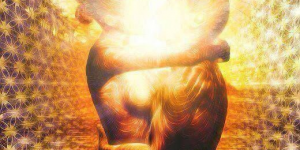
Two salient features of the birth of the inner Christ are ecstatic absorption in the Divine and selfless love transcending the bounds of the ego. In love-making, we begin to experience, albeit initially in small measure, these states of ecstasy that take us beyond the constraints and limitations of our fear-based egos. These ecstatic states are but precursors to the much greater joy and fulfillment awaiting us when we become one with God. Thus, when we weave together love-making with other spiritual practices, such as prayer, meditation, visualization and selfless service, our love-making takes on a wondrous and hallowed place in our journeys to God.
IX. The Unwise Use of Sexual Energy – Part I
The subject of sexual energy is vast, and no discussion of it will exhaust the many facets of this titanic force. Just as we must enter into the depths of the heart chakra and its purity of love to truly know love’s magic, we must come to know intimately sexual energy and its power to transform us in fundamental ways in order to truly understand the prolific role it can play in our lives. Because sexual energy is so powerful and holds many secrets, those who dare to explore the deeper mysteries of love-making will be well-served to know not only the wise use of sexual energies but also the perils and pitfalls of their misuse. In this sense, the importance of wisely using sexual energies can be better understood when standing in relief against their misuses and the consequences flowing from them.
This section and the following address some of the more common misuses of sexual energies. We will look at how these misuses can imperil the unfolding of the light within us and jeopardize the attainment of the freedom to which most of us aspire in the depths of our souls. The discussion will be informed by Jesus’ warnings of the dangers arising from misuse of the energies of the chakras, including those associated with sex, in the Parable of the Bridesmaids and in the Revelation to John, and the truths that these teachings reveal about spiritual transformation and salvation.
The energies of the lower chakras have many vital functions. For example, the root chakra, the lowest of the seven major chakras, is essential for being grounded in the world, defending oneself when needed, fueling one’s efforts to attain goals in life, and, of course, procreation. These uses of sexual energies serving survival and success in the world are deeply interwoven with biological processes. Science has learned much about the physical body but little about subtle energies and their interactions with the physical body. Subtle energies and how they affect biological processes is an exciting new frontier awaiting Western science and medicine. Knowledge of the relationship between subtle energies and the physical body, which forms the basis of many traditional healing practices, can potentially revolutionize Western medicine and its understanding of health and illness.
The subtle energies of the chakras being, in essence, spiritual, the effects of these energies are not limited to the physical, but have higher purposes related to our natures as spiritual beings. In love-making, as we have seen, the energies of the lower chakras have a special spiritual role. They expand and deepen the lovers’ heart chakras and cleanse and clear them, lifting the lovers to a higher vibration of energy and initiating them into Divine Love dwelling beyond the depths of their heart chakras. Love-making, envisioned in this way, is an avenue to awaken lovers spiritually and to bring them into states of higher consciousness.
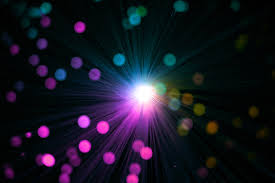 But the opposite also holds true. When we misuse our sexual energies and the misuse becomes a pattern in our lives, we create within ourselves a low vibration of energy, which lowers the vibration of the energy field around us. A low vibration of energy surrounding and interpenetrating our physical bodies will hold us at a low level of consciousness, for levels of consciousness are largely determined by the quality of the energies we carry. Sexual intimacy at a diminished level of consciousness will be experienced primarily as a physical act in pursuit of physical excitation and pleasure. Sexual intimacy experienced predominantly in this way hinders us from coming to know the fullness of ourselves as sexual beings and the power of our sexual energies to bring us into higher spiritual states.
But the opposite also holds true. When we misuse our sexual energies and the misuse becomes a pattern in our lives, we create within ourselves a low vibration of energy, which lowers the vibration of the energy field around us. A low vibration of energy surrounding and interpenetrating our physical bodies will hold us at a low level of consciousness, for levels of consciousness are largely determined by the quality of the energies we carry. Sexual intimacy at a diminished level of consciousness will be experienced primarily as a physical act in pursuit of physical excitation and pleasure. Sexual intimacy experienced predominantly in this way hinders us from coming to know the fullness of ourselves as sexual beings and the power of our sexual energies to bring us into higher spiritual states.
Hence, if we misuse our sexual energies, we consign ourselves to lives bound by the many limitations that come from living at a low level of consciousness. Most people simply do not know the many adverse and even harmful effects that come from misusing sexual energies. They have never been taught. Knowing the harm we may do to ourselves and others when we misuse sexual energies may help us make informed and hopefully wise choices, especially when we come to see clearly the repercussions of the misuse of sexual energies on myriad aspects our lives, including the spiritual.
[pullquote]The subtle energies of the chakras being, in essence, spiritual, the effects of these energies are not limited to the physical, but have higher purposes related to our natures as spiritual beings.[/pullquote]One of the most common misuses of sexual energy is loveless sex, which occurs when we have sex when our heart chakra is closed. For some people whose heart chakras are closed, sexual intimacy with a partner who is desired and respected in a committed relationship will spark the opening of their closed heart chakra. But when the heart chakra is closed and love is absent, the sexual encounter almost invariably does not rise to the level of love-making, being consummated at best as an act of physical pleasure. Sexual intimacy at this level may bring physical gratification, but falls far short of the much greater pleasures experienced when lovers’ heart chakras are open. When their heart chakras are open, lovers experience the physical pleasure of sexual intimacy, but also the much greater joy of love-making on energetic and spiritual levels, which in their higher expressions border on bliss.
Loveless sex also impedes the flow of energies of the lower chakras. If the heart chakra is closed, sexual energies do not flow into it. Instead, they remain stuck or blocked in and around the lower chakras, encumbering or obstructing altogether the healthy flow of these vital energies. Blocked and stuck energies harm us spiritually because their low vibration entraps us at a low level of consciousness, where we remain estranged from the higher energy of love and the exalted, and even magical, feelings that come alive within us as love vibrates throughout our energy field. Blocked and stuck energies also can harm our physical and psychological health. Physical and psychological well-being depends in large measure on our subtle energies flowing and vibrating at high levels. Many maladies of mind and body are caused by subtle energies that are blocked and vibrating at low levels.
Loveless sex is also detrimental in that it dissipates our sexual energies, which are our life force. When love is absent, sexual energies are released but do not transform. They do not flow into the heart chakra and, joined with the energy of love, expand the heart chakra and the energy field. Instead, the release of sexual energies sans an open heart weakens us, as our life force is spent in spiritually sterile acts. Instead of enhancing and transforming in life-giving ways, loveless sex diminishes us on all levels: physical, psychological, energetic, and spiritual. It becomes difficult to come into states of higher consciousness when we are lessened in all these ways. On a more sinister note, loveless sex opens a person to having subtle energies taken from them. Unfortunately, predatory men and women can use sex to access others energetically and rob them of energy. Some people will feel a depletion or loss of energy in loveless sex and conclude, wisely, that it is not for them.
[pullquote]One of the most common misuses of sexual energy is loveless sex, which occurs when we have sex when our heart chakra is closed.[/pullquote]Loveless sex also entails exchanges of energies that leave each partner carrying the other’s energies. Exchanges of energies are natural in sexual encounters. When love is absent, though, the energies transferred between partners are not transformed. What then follows is that each partner ends up carrying the other’s untransformed energies. A partner’s energies may be of a low vibration and even dark, which is not unusual because most people do not live at high vibrations of energy or consciousness. Consequently, partners engaging in loveless sex can easily take on each other’s low and sometimes dark energies, whether they are aware of it or not, with little chance of these energies being transformed into energies of a higher vibration, which is what love would do.
In contrast, when lovers’ heart chakras are open, they exchange energies, but what happens in the exchanges is different. Exchanges of energies are part and parcel of lovers’ commitment to each other. But, unlike in loveless sex, lovers’ sexual energies flow naturally into their open heart chakras, a flow that can be enhanced by the lovers consciously directing sexual energies into their heart chakras. These energies merged with the energies of the heart chakra have the power to transform low or dark energies that may have been exchanged during love-making. So, in a committed relationship, lovers will exchange subtle energies, including those that may be of a lower vibration and even dark. But, distinct from loveless sex, as the lovers’ heart chakras open more and more in their love-making, as well as through other spiritual practices (such as meditation and visualization), the higher vibration of love flowing from their heart chakras, over time, will cleanse the lovers of low or dark energies. Thus, amidst the pleasures of their love-making, lovers can transform energies that are not of light and love, aiding each other in this most important task in their journeys to God.
The problems coming from taking on another’s energies during loveless sex become compounded when a person has multiple sexual partners. A person having several sexual partners takes on energies from each partner. Unbeknownst to most people, a sexual partner’s energies remain in one’s energy field long after sex is over and, in some cases, for a lifetime. Consequently, energies taken on during sex keep us tied to the person whose energies we carry. Even a casual sexual encounter may create energetic ties that bind for a long time and, possibly, for the duration of our lives. Carrying the untransformed energies of multiple partners can, in addition to lowering our energy and consciousness, create in us a diminished sense of self. Our sense of self, unique to each of us, is determined, in large measure, by the quality and nature of the subtle energies we carry, which in turn greatly influence the course of our lives. Carrying many partners’ energies, especially those that are low or dark, can cause us to lose our sense of self and lead us astray as to the distinctive purpose and path in life unique to us.
X. Unwise Use of Sexual Energies – Part II
Another misuse of sexual energies is to repress them. This may happen when we are taught that sex is only for limited purposes, such as procreation or the sexual satisfaction of one’s partner out of a sense of conjugal duty. Sex for other purposes is then proscribed as off limits and even deviant. Sexual energies may also be repressed when we are taught that sex is somehow inimical to our spiritual natures. Such misguided beliefs are often found in religious teachings born out of fear of sexual energies and their power. Such errant tenets create an unnatural split between a person’s religious values and her innate desire for the joyful and even ecstatic experiences of love-making. Well-intended persons with religious sensibilities may sacrifice the fullness of their sexual lives to the mistaken belief that “overcoming” the desire for the joy and ecstasy of love-making will bring them closer to fulfilling their religious aspirations.
Jesus alludes to the repression of subtle energies in the Parable of the Talents (Mt 25:14-30), another teaching shedding light on the use and misuse of subtle energies. Jesus opens the parable by saying that it is a teaching on the very thing that sits at the  heart of his mission: the kingdom of heaven. Mt 25:14. He then tells of a master about to travel to a far country. The master gives to a servant five talents, to another servant two talents, and to a third servant one talent. While he is away, the servant with five talents uses them to earn five more, and the servant with two talents uses them to earn two more. Upon the master’s return, these two servants deliver to him the talents he gave them plus those they earned. He praises them profusely, saying: “Well done good and faithful servants; you have been faithful over a few things, I will make you ruler over many things. Enter into the joy of your Lord.” Mt 25: 21, 23 (emphasis added).
heart of his mission: the kingdom of heaven. Mt 25:14. He then tells of a master about to travel to a far country. The master gives to a servant five talents, to another servant two talents, and to a third servant one talent. While he is away, the servant with five talents uses them to earn five more, and the servant with two talents uses them to earn two more. Upon the master’s return, these two servants deliver to him the talents he gave them plus those they earned. He praises them profusely, saying: “Well done good and faithful servants; you have been faithful over a few things, I will make you ruler over many things. Enter into the joy of your Lord.” Mt 25: 21, 23 (emphasis added).
But the master harshly rebukes the servant given one talent, who tells the master he did not earn more talents because he was afraid and hid his talent. The master rejects the servant’s excuse, vilifying him as wicked and lazy. The master then takes the one talent from the hapless servant and gives it to the servant with ten talents, saying: “For to everyone who has, more will be given, and he will have abundance; but from him who does not have, even what he has will be taken away.” Mt 25:29.
At first blush, this parable, like the Parable of the Bridesmaids, appears to a have a distinctly unchristian message. Instead of forgiveness and understanding, the servant given one talent is harshly judged and, like the foolish virgins, is “cast into darkness…where there will be weeping and gnashing of teeth.” Mt 25:30. We might ask why the servant is not forgiven: “Then Peter came to Him and said, ‘Lord, how often shall my brother sin against me, and I forgive him? Up to seven times?’ Jesus said to him, ‘I do not say to you, up to seven times, but up to seventy times seven.’” Mt 18: 21-22. We may also wonder why the servant’s transgression is so grave in the eyes of the master. After all, the servant did not squander the talent but returned it to his master.
[pullquote]Another misuse of sexual energies is to repress them.[/pullquote]When we understand the talents to represent the energies that God has given us, in the measure corresponding to each of us, we can see that Jesus is teaching about our subtle energies, which are an important part of our spiritual patrimony from God. Persons who are blessed with an abundance of energy are called to use it to create more energy. Energy bequeathed by God is a form of light, and light begets light. When we fail to use our energies of light to create more light in ourselves, in others and in our world, we fail to do God’s work. We do not transform ourselves and the world into God’s image, which is Light. Thus, the servant who hid his talent and failed to use it to create more is like those persons who repress their sexual energies and fail to use these powerful spiritual forces to create more light and love in themselves and the world. It takes wisdom and courage to live fully one’s sexual energies in enlightened and loving ways and not to be remiss in the use of this divine gift as was the servant who buried the single talent given him. And, as Jesus said, the deeper meaning of the parable is about the kingdom of heaven, again linking attainment of the kingdom to how we choose to use our subtle energies.
When we misuse sexual energies, in whatever form it may take, we forfeit the bounty and beauty these energies are meant to bring to us. We diminish ourselves spiritually, weaken ourselves physically and psychologically, and undermine our efforts to attain higher spiritual states. Deprived of these vital forces, we cannot sustain ourselves and others at high vibrations of energy and levels of consciousness. Ultimately, misuse of our sexual energies imperils the realization of our highest purpose: union with the Divine. We become, instead, imprisoned in low vibrations of energy and low, and sometimes dark, levels of consciousness. These states may feel normal for many people because they do not know anything different.
Misuse of sexual energies has untoward consequences not only for us as individuals but for our all humankind and even for the destiny of our planet. Like us, the earth is an energetic being, and its energies interact with ours on many levels. The misuse of subtle energies lowers the vibration of the planet, which then cannot support us as a life-giving being coexisting with us in a beautifully choreographed and interdependent relationship. The Book of Revelation, in passages relating to the seven seals and seven bowls, speaks of how the impact of the misuse of the energies of the chakras is not limited to us individually but affects all humankind and even the planet upon which we depend for our survival.
XI. Attacks on the Light
Misuse of sexual energy reaches a level of malevolence when sex is coerced or forced in acts of sexual abuse and rape. These egregious violations of another person, especially when the victims are children, have devastating effects, and the wounds inflicted are hard to heal. The violated person is often left with a deeply impaired relationship with their body and sex, making it difficult for them to later experience the fullness of love-making. Persons who have been violated sexually often end up fearing or being repulsed by sex or having sex in ways in which they are closed off emotionally and energetically. This greatly harms, and may destroy altogether, a person’s ability to experience sexual intimacy as an act of love and as a path to attaining higher spiritual states.
[pullquote]Misuse of sexual energy reaches a level of malevolence when sex is coerced or forced in acts of sexual abuse and rape.[/pullquote]When we recognize the great potential for spiritual transformation that lies in our sexual energies, we can see that sexually violating another person is an attack on the person’s light. We are spiritual beings meant to carry light and love and to become light and love. Violating others sexually diminishes their light and damages their capacity to love, inflicting harm in the very areas of their lives meant to be among the most vibrant and beautiful pathways to grow in light and love. Sexual violations often keep violated persons trapped in darkness, in the form of fears, anger and depression, which can persist throughout their lives. As such, sexual violations are not just attacks on the light but transgressions in service of the darkness.
The promotion of the misuse of the body and sexual energy in popular culture also serves the ends of darkness. Pornography is a rape not of the body, but of the soul, especially the souls of innocent children who are indoctrinated with false and misleading notions about their bodies and sex at formative stages of their lives. Many young people are initiated into what might be considered the cult of loveless sex before they have had the opportunity to learn of the beauty and higher spiritual purposes of love-making. Before reaching adulthood, they often are handicapped emotionally and psychologically by having fallen unwittingly under the seductive spell of loveless sex promoted in many forms of contemporary media. They are beguiled into approaching sex primarily as physical gratification and misled into believing that sex without commitment or with multiple sexual partners is harmless.
[pullquote]Pornography is a rape not of the body, but of the soul, especially the souls of innocent children who are indoctrinated with false and misleading notions about their bodies and sex at formative stages of their lives.[/pullquote]Most people are unknowing about the perils of the misuses of the body and sexual energy, including how they can diminish the light and love within them. After all, most people are not taught that, in their essence, they are light and that their deeper longings will be fulfilled not through physical pleasure, but by coming to know their inner essence of light and living it in love, as did Jesus when he walked the earth. Sex and sexual energies are integral us as spiritual beings. Children at appropriate ages can and should be taught about the specialness of their bodies and the spiritual energies of the churches that they carry within them. When children come to know the spiritual life within them and its wondrous possibilities, they will be more likely, as they grow older, to approach sex in ways that do not harm themselves or others.
(For a discussion of light and darkness in Jesus’ teachings, see The Apocalypse of Light in the New Testament at www.christianityandthechakras.com.)
XII. Beyond the Biological
The energies of the chakras, we are told in Christian Scripture and the teachings of Eastern spiritual masters, are spiritual and come from God. John in Revelation describes them as “the Spirits of God”, Paramahansa Yogananda characterizes them as spiritual, and Swami Yuktewar says they carry divine consciousness. As such, the energies of the chakras are indispensable to our identities as spiritual beings. They also set us apart from other creatures in the natural world. Paramahansa Yogananda points out this truth when he writes: “Man’s body, unique among all creatures, possesses spiritual cerebrospinal centers of divine consciousness in which the descended Spirit is templed.” (The Second Coming of Christ, Vol I, p. 109).
 While animals have subtle energies as do humans, animals do not have the system of chakras identified by Parahamansa Yogananda as unique to humans. In other words, while we share much with other mammals, we are fundamentally different from then in that we are endowed with spiritual energies that other mammals are not. Human sexuality, then, can never be understood to be on par with sex in the animal world, because sex in the animal kingdom does not involve chakras and their spiritual energies. Thus, sex for humans, far more than what it is for animals, is not meant to be a carnal act in pursuit of physical pleasure. And, unlike in the animal world, the purposes of sex in the human sphere reach far beyond procreation and the survival of the species.
While animals have subtle energies as do humans, animals do not have the system of chakras identified by Parahamansa Yogananda as unique to humans. In other words, while we share much with other mammals, we are fundamentally different from then in that we are endowed with spiritual energies that other mammals are not. Human sexuality, then, can never be understood to be on par with sex in the animal world, because sex in the animal kingdom does not involve chakras and their spiritual energies. Thus, sex for humans, far more than what it is for animals, is not meant to be a carnal act in pursuit of physical pleasure. And, unlike in the animal world, the purposes of sex in the human sphere reach far beyond procreation and the survival of the species.
XIII. A Spiritual Ethos of Sexual Energy
Jesus taught that we can use the energies of the chakras properly or improperly. He also instructed that we will live with the effects, for good or bad, arising from our choices as to how we use these energies. If the use or misuse of the energies of the chakras has major consequences for us spiritually, as the gospels teach, it would follow that persons on a spiritual path would want to use these energies in ways that would further then in the fulfillment of their highest spiritual aspirations. Such normative considerations would provide insight and understanding that would help persons make the best choices as to their use of the energies of all the chakras, including those of the two lower chakras.
Such an ethos, informed by knowledge of the subtle energies of the chakras and their divine nature, would differs from the moral strictures governing sex and sexual behavior that official Christendom has prescribed, and often enforced, throughout much of its history. Such a new ethos would guide spiritual seekers to use their energies, including sexual energies, in ways they deem congruent with their natures as spiritual beings and their higher spiritual aspirations.
One standard arising from such an ethos, and perhaps the most important, would be to use our sexual energies in the service of love. Such a standard, in most instances,  would translate into being sexually intimate only with a partner who is loved in a committed relationship. This special bond between lovers would create the conditions for their sexual energies to come alive during love-making and flow into their heart chakras, creating in them more light and giving birth in them to a greater capacity to love. And the more they love and become filled with the energy of love, the closer they will come to God, the source of all love.
would translate into being sexually intimate only with a partner who is loved in a committed relationship. This special bond between lovers would create the conditions for their sexual energies to come alive during love-making and flow into their heart chakras, creating in them more light and giving birth in them to a greater capacity to love. And the more they love and become filled with the energy of love, the closer they will come to God, the source of all love.
Such a spiritual ethos of sexual energy would join our desire for sexual fulfillment and our longing for oneness with God, redeeming our sexual energies for the pursuit of the higher purposes they are meant to help us fulfill. We will then no longer carry a split between sexual desires and spiritual longings, as we find in Jesus’ teachings the union of the two.
XIV. Final Thoughts
Knowledge of the chakras makes possible for us to see New Testament texts in a new light in which we come to know higher truths taught by Jesus. These truths have the potential to transform Christian spirituality. They allows us to see that Jesus taught about the energy centers known as chakras, including those associated with sex, and their unique role in spiritual transformation. Spiritual in nature, the energies of these churches have the power to transform us spiritually, lifting us into a higher spiritual states and bringing us into union with our divine natures and with God. As we open the chakras in love, especially the heart chakra, their energies will blossom within us, filling us with their light. And the more we are filled with their light, including the light that comes alive in us during love-making, the closer we will come to knowing our divine essence and becoming one with God. Then we will come to know in its fullness the gift of salvation that Jesus offered, in his life and in his teachings, to us and our world.

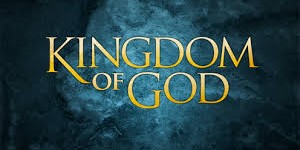 Many Jews of Jesus’ time lived with the expectation of a messiah who would establish an earthly kingdom that would restore the glory of King David’s kingdom. The gospels make clear that the establishment of an earthly kingdom was not Jesus’ purpose (e.g., Jn 18:36). Many Christians over the centuries came to believe that the kingdom of God would be attained after death by persons who had lived a virtuous life based on gospel precepts. This interpretation finds little support in the New Testament. For example, Paul did not understand the kingdom to be attained when the soul left the body after death. Instead, he wrote of putting on the incorruptible or spiritual body when we are transformed in Christ. 1 Cor 15, 2 Cor 5, Col 3. If what Jesus proclaimed was neither an earthly kingdom nor a place where virtuous souls go after death, what is the kingdom he proclaimed and how is it be attained?
Many Jews of Jesus’ time lived with the expectation of a messiah who would establish an earthly kingdom that would restore the glory of King David’s kingdom. The gospels make clear that the establishment of an earthly kingdom was not Jesus’ purpose (e.g., Jn 18:36). Many Christians over the centuries came to believe that the kingdom of God would be attained after death by persons who had lived a virtuous life based on gospel precepts. This interpretation finds little support in the New Testament. For example, Paul did not understand the kingdom to be attained when the soul left the body after death. Instead, he wrote of putting on the incorruptible or spiritual body when we are transformed in Christ. 1 Cor 15, 2 Cor 5, Col 3. If what Jesus proclaimed was neither an earthly kingdom nor a place where virtuous souls go after death, what is the kingdom he proclaimed and how is it be attained?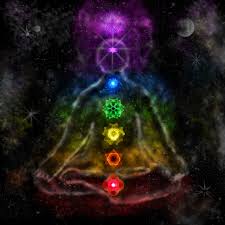
 The heart chakra and its energy of love also play a significant role when we fall in love. In fact, the opening of the heart chakra is probably the most defining characteristic of falling in love. When we fall in love our heart chakra opens to a deeper level and our entire energy field becomes filled with love’s high energetic vibration. This vibration gives falling in love its magical quality as we are lifted into a higher energetic frequency and feel transformed by it. Life and the world take on new meaning. The heart chakra and the high vibration of love flowing from it help to explain why falling in love is such a powerful and, potentially, spiritually transforming experience.
The heart chakra and its energy of love also play a significant role when we fall in love. In fact, the opening of the heart chakra is probably the most defining characteristic of falling in love. When we fall in love our heart chakra opens to a deeper level and our entire energy field becomes filled with love’s high energetic vibration. This vibration gives falling in love its magical quality as we are lifted into a higher energetic frequency and feel transformed by it. Life and the world take on new meaning. The heart chakra and the high vibration of love flowing from it help to explain why falling in love is such a powerful and, potentially, spiritually transforming experience. A major teaching on the chakras and their energies is found in Jesus’ parable of the wise and foolish virgins, also known as the Parable of the Bridesmaids. In this parable, ten virgins with lamps and oil await the arrival of the bridegroom. Five of the virgins burn their oil while the five do not. When the bridegroom’s arrival is delayed, the virgins who burnt their oil run out of it, and they ask the other virgins to share their oil with them. The wise virgins, in what seems to be a selfish response, refuse to share their oil, and the virgins without oil leave in search of oil. In their absence, the bridegroom arrives and the wedding feast commences. When the virgins who went in search of oil return, they are barred from entering the wedding feast.
A major teaching on the chakras and their energies is found in Jesus’ parable of the wise and foolish virgins, also known as the Parable of the Bridesmaids. In this parable, ten virgins with lamps and oil await the arrival of the bridegroom. Five of the virgins burn their oil while the five do not. When the bridegroom’s arrival is delayed, the virgins who burnt their oil run out of it, and they ask the other virgins to share their oil with them. The wise virgins, in what seems to be a selfish response, refuse to share their oil, and the virgins without oil leave in search of oil. In their absence, the bridegroom arrives and the wedding feast commences. When the virgins who went in search of oil return, they are barred from entering the wedding feast. As such, Revelation’s symbolic use of lampstands and churches to refer to the chakras, which are also referred to as seven bowls and seven seals, if nothing else, served to ensure he teachings would not be rejected as heresy by what later became the official Church and that they would be available to those, as Jesus states In Revelation, who could understand Revelation’s symbolic truths: “He who has an ear, let him hear what the Spirit says to the seven churches.” Rev 2:7. We today, hopefully, are among those who can hear what is being revealed.
As such, Revelation’s symbolic use of lampstands and churches to refer to the chakras, which are also referred to as seven bowls and seven seals, if nothing else, served to ensure he teachings would not be rejected as heresy by what later became the official Church and that they would be available to those, as Jesus states In Revelation, who could understand Revelation’s symbolic truths: “He who has an ear, let him hear what the Spirit says to the seven churches.” Rev 2:7. We today, hopefully, are among those who can hear what is being revealed. We thus see in the gospels and in Revelation that Jesus knew about the chakras and taught about them as keys to spiritual transformation and union with the Divine. Jesus’ teachings and mission are illuminated by understanding the chakras and their energies. In his transfiguration on Mount Tabor and in his appearance to John in Revelation, Jesus shows us that to be like him is to be filled with light. These revelations, moreover, affirm what we are told in the opening verses of the Gospel of John: that Jesus is light and that we too are light. Jn 1:1-9. Knowing about the chakras, the churches within us, takes on critical importance in order for us to become, like Jesus, filled with light and to understand more fully what he taught as salvation, which involves the transformation from human to divine consciousness. One of the chakras, the heart chakra, plays a special role in this transformation and, even more importantly, in knowing what Jesus preached as the kingdom of God.
We thus see in the gospels and in Revelation that Jesus knew about the chakras and taught about them as keys to spiritual transformation and union with the Divine. Jesus’ teachings and mission are illuminated by understanding the chakras and their energies. In his transfiguration on Mount Tabor and in his appearance to John in Revelation, Jesus shows us that to be like him is to be filled with light. These revelations, moreover, affirm what we are told in the opening verses of the Gospel of John: that Jesus is light and that we too are light. Jn 1:1-9. Knowing about the chakras, the churches within us, takes on critical importance in order for us to become, like Jesus, filled with light and to understand more fully what he taught as salvation, which involves the transformation from human to divine consciousness. One of the chakras, the heart chakra, plays a special role in this transformation and, even more importantly, in knowing what Jesus preached as the kingdom of God. Thereupon he sees a door standing open and One seated upon a throne. Rev 4:2. The open door may be interpreted as John’s experience of having, within the innermost depths of his heart chakra, opened to the pure Light and Love within him, which he describes as the One. This passage may be telling us that John, who was known as the most beloved of Jesus’ disciples, attained the purity of heart that allowed him to directly experience the Divine. The passages preceding John’s encounter with the One are revelations about the chakras. It therefore is reasonable to conclude that John’s experience of the open door also speaks of the chakras and, more specifically, the heart chakra and what lies beyond its depths: an encounter with the Divine.
Thereupon he sees a door standing open and One seated upon a throne. Rev 4:2. The open door may be interpreted as John’s experience of having, within the innermost depths of his heart chakra, opened to the pure Light and Love within him, which he describes as the One. This passage may be telling us that John, who was known as the most beloved of Jesus’ disciples, attained the purity of heart that allowed him to directly experience the Divine. The passages preceding John’s encounter with the One are revelations about the chakras. It therefore is reasonable to conclude that John’s experience of the open door also speaks of the chakras and, more specifically, the heart chakra and what lies beyond its depths: an encounter with the Divine. When one comes to know one’s divine essence, Jesus seems to be saying, one’s heart chakra will open to the Light within and that Light will flow from the well spring of the heart chakra like “rivers of living water”. In other words, the high vibration of Divine Love and Light, which is one’s Christ essence, or one’s Sacred Heart, will flow from the depths of one’s heart chakra when one has come, like John, to truly know the Christ within. Jesus spoke of this knowing when he foretold to his disciples their experience of the inner Christ and the union it would bring with him and with God: “At that day you will know that I am in My Father, and you in Me, and I in you.” Jn 14:20.
When one comes to know one’s divine essence, Jesus seems to be saying, one’s heart chakra will open to the Light within and that Light will flow from the well spring of the heart chakra like “rivers of living water”. In other words, the high vibration of Divine Love and Light, which is one’s Christ essence, or one’s Sacred Heart, will flow from the depths of one’s heart chakra when one has come, like John, to truly know the Christ within. Jesus spoke of this knowing when he foretold to his disciples their experience of the inner Christ and the union it would bring with him and with God: “At that day you will know that I am in My Father, and you in Me, and I in you.” Jn 14:20.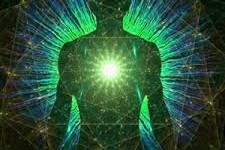 attained as in Eastern traditions through the third-eye chakra or as Jesus taught through the heart chakra. In Western culture, the heart chakra transformed in love appears to be the royal road to the Divine, the path by which we enter into the Divine Romance and find that the ultimate love and the ultimate lover is God. It is then that we come to know what Jesus meant by the kingdom of God, the kingdom that he came to earth to proclaim. And we can better understand what he told a scribe who professed belief in love as the highest commandment: “You are not far from the kingdom of God.” Mk 12:34.
attained as in Eastern traditions through the third-eye chakra or as Jesus taught through the heart chakra. In Western culture, the heart chakra transformed in love appears to be the royal road to the Divine, the path by which we enter into the Divine Romance and find that the ultimate love and the ultimate lover is God. It is then that we come to know what Jesus meant by the kingdom of God, the kingdom that he came to earth to proclaim. And we can better understand what he told a scribe who professed belief in love as the highest commandment: “You are not far from the kingdom of God.” Mk 12:34. indeed, the kingdom of God is within you.” Lk 17: 20-21. The Greek words translated as “within” in this passage are entos hymin, which also can be translated “in your midst” or “within your grasp”. A very similar description of the kingdom is found in the non-canonical Gospel of Thomas in which Jesus states that the kingdom is both inside and outside us: “If your leaders say to you, ‘Look, the kingdom is in heaven,’ the birds of heaven will precede you. If they say to you, ‘it is in the sea,’ then the fish will precede you. Rather, the kingdom of God is inside you and outside you.” Gospel of Thomas 3:1-3.
indeed, the kingdom of God is within you.” Lk 17: 20-21. The Greek words translated as “within” in this passage are entos hymin, which also can be translated “in your midst” or “within your grasp”. A very similar description of the kingdom is found in the non-canonical Gospel of Thomas in which Jesus states that the kingdom is both inside and outside us: “If your leaders say to you, ‘Look, the kingdom is in heaven,’ the birds of heaven will precede you. If they say to you, ‘it is in the sea,’ then the fish will precede you. Rather, the kingdom of God is inside you and outside you.” Gospel of Thomas 3:1-3. parables Jesus teaches that the kingdom has many facets, as he uses different parable to teach different truths about the kingdom. Taken together, these truths reflect the majestic and miraculous nature of the kingdom, as the many facets of a gem reflect its opulence as a whole. Gospel passages explaining why Jesus taught in parables also reveal truths about the kingdom, as they speak to the difficulty that even Jesus had of making it known.
parables Jesus teaches that the kingdom has many facets, as he uses different parable to teach different truths about the kingdom. Taken together, these truths reflect the majestic and miraculous nature of the kingdom, as the many facets of a gem reflect its opulence as a whole. Gospel passages explaining why Jesus taught in parables also reveal truths about the kingdom, as they speak to the difficulty that even Jesus had of making it known.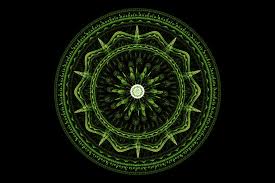 chakra, then, takes on crucial importance to the birth of the kingdom within us, for it is in the depths of the heart chakra that we will come to know love and the mind of love that allows us to let go of the ego and its attachment to the ordinary mind. This transformation is a rebirth into the Light and Love that is our birthright, the kingdom to which we belong as children of God. Jesus thus counsels Nicodemus, “Most assuredly, I say to you, unless one is born again, he cannot see the kingdom of God.” Jn 3:3.
chakra, then, takes on crucial importance to the birth of the kingdom within us, for it is in the depths of the heart chakra that we will come to know love and the mind of love that allows us to let go of the ego and its attachment to the ordinary mind. This transformation is a rebirth into the Light and Love that is our birthright, the kingdom to which we belong as children of God. Jesus thus counsels Nicodemus, “Most assuredly, I say to you, unless one is born again, he cannot see the kingdom of God.” Jn 3:3.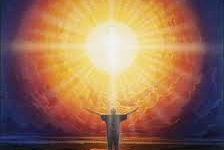 understood, give us a better understanding of the kingdom and how to attain it. When we live and love from the depths of the heart chakra, we open to the “hidden chamber” beyond its depths and encounter our essence of Light and Love and our identities as children of God. It is then that we enter the kingdom of God and become one with the Divine, the salvation Jesus offered to humankind. This transformation comes when we live love as our highest value and choose to let go of the ego and the ordinary mind and to enter into the mind of love and its endless possibilities that await us within the depths of our heart chakras.
understood, give us a better understanding of the kingdom and how to attain it. When we live and love from the depths of the heart chakra, we open to the “hidden chamber” beyond its depths and encounter our essence of Light and Love and our identities as children of God. It is then that we enter the kingdom of God and become one with the Divine, the salvation Jesus offered to humankind. This transformation comes when we live love as our highest value and choose to let go of the ego and the ordinary mind and to enter into the mind of love and its endless possibilities that await us within the depths of our heart chakras. strength and courage to love in the face of the darkness and adversity that we will invariably encounter. We can also ask Jesus to come into our heart chakras and help us to cleanse them of all that is not love. Jesus’ high vibration of Light and Love together with our desire to love can dispel any darkness we may carry and heal even the deepest wounds our hearts have known. Jesus also urged that we live for others, doing for others and giving to others. Acting for the well-being of others is honored in most religious traditions as a way to overcome the ego’s selfishness, especially when our doing and giving come from the heart. Living selflessly is also a way taught in many religions to undo the injustices of the world.
strength and courage to love in the face of the darkness and adversity that we will invariably encounter. We can also ask Jesus to come into our heart chakras and help us to cleanse them of all that is not love. Jesus’ high vibration of Light and Love together with our desire to love can dispel any darkness we may carry and heal even the deepest wounds our hearts have known. Jesus also urged that we live for others, doing for others and giving to others. Acting for the well-being of others is honored in most religious traditions as a way to overcome the ego’s selfishness, especially when our doing and giving come from the heart. Living selflessly is also a way taught in many religions to undo the injustices of the world.
